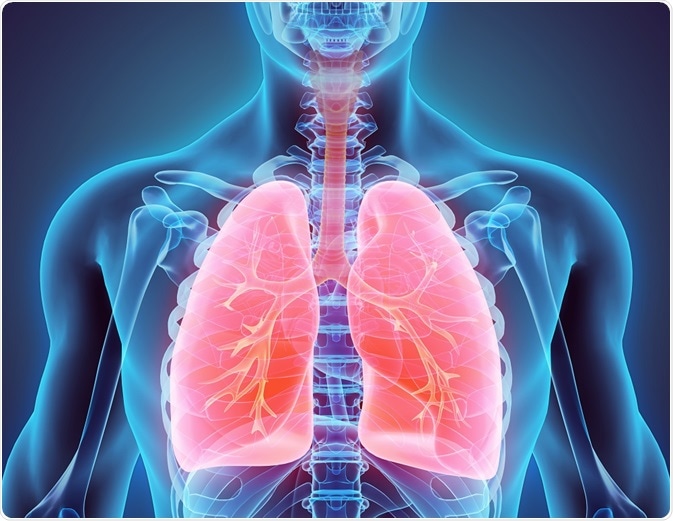
Chronic Obstructive Pulmonary Disease Treatment
Chronic Obstructive Pulmonary Disease (COPD) refers to a collection of lung diseases that are characterized by breathing difficulties.

Credit: yodiyim/Shutterstock.com
COPD usually affects middle aged adults, and is especially prominent in those who smoke or used to smoke. It is a progressive disorder, which means that it gets worse over time.
The two most common lung conditions associated with COPD are Emphysema and Chronic Bronchitis.
Emphysema refers to the condition where the alveoli, or small air sacs, present in the lungs are destroyed. It is be caused by inhaling cigarette smoke, harmful gases and particulate matter from the atmosphere.
As the alveoli break down, the lungs become riddled with holes and lose their elasticity. These holes trap air, preventing the lungs from exchanging air correctly, this makes taking a breathing a laborious process.
Chronic Bronchitis affects the bronchioles (airways) of the lungs. The lining of the bronchial tubes becomes inflamed, causing the airways to constrict.
As the space within the bronchial tubes decreases, it makes it more difficult for air to be delivered to the lungs, causing the individual to struggle for breath. Patients often experience a daily cough accompanied by heavy mucus and phlegm.
What Causes Chronic Obstructive Pulmonary Disease?
There are a number of risk factors associated with the development of COPD. The damage done to the lungs is permanent and irreversible. Fortunately, it is completely preventable. The main causes of COPD are:
Smoking – tobacco smoke is the most prominent cause of COPD. The more smoke an individual inhales, the more damage is done to the lungs. Smokers of cigarettes, cigars, pipes, and even marijuana are at risk.
Asthma and Smoking – asthmatics carry a much higher risk of ending up with COPD. Smoking aggravates the condition and the damage inflicted is permanent. It also occurs at a much more rapid rate.
Workplace Chemicals and Dust – exposure to chemical fumes, toxic vapors and particulate matter at the workplace or in a polluted living environment can also cause inflammation of the lungs. Studies have shown that in the long-term, this can lead to COPD.
Burning Fuel Fumes – in less developed countries, individuals often burn material in their homes, exposing their lungs to fuel fumes. Poor ventilation means that the fumes do not escape and the individuals are exposed to the toxins for a long period of time, making them vulnerable to developing COPD.
Genetic Predisposition – while it is extremely rare, there is a genetic disorder known as alpha-1-antitrypsin deficiency which can cause COPD.
How is Chronic Obstructive Pulmonary Disease Treated?
Complications such as respiratory infections, heart problems, lung cancer, high blood pressure and depression often accompany COPD.
These conditions result in permanent lung damage which cannot be healed or reversed. However, it is now possible to contain the damage and slow the progression of the disease. Treatment options include:
Quitting Smoking
If you have been diagnosed with COPD, and are still smoking, it’s time to stop. Join a program that helps you quit smoking. Being part of a group will give you a greater chance at success. Also avoid areas where second hand smoke, dust and fumes are prevalent, as these can irriate damaged lungs.
Medication
Inhalers deliver medicine straight to the airways of the lungs. Bronchodilators are inhalers which relax the muscles around the airways and can be long or short-acting. They can ease a wheezing cough, breathlessness and difficulty breathing.
Corticosteroid medication can also be delivered by an inhaler. These medicines help by reducing the inflammation in the airways,Some inhalers may be a combination of both bronchodilators and corticosteroids.
Oral medication may be provided to deal with severe exacerbation for short periods of time. Examples include steroids, antibiotics, and phosphodiesterase-4 inhibitors.
These medicines work by reducing inflammation and relaxing the airways, making breathing easier. Low doses of theophylline can help improve breathing, but may have side effects like headaches, nausea and heart tremors.
Lung Therapies
Individuals suffering from severe COPD may be offered oxygen therapy to increase the level of oxygen in the blood and improve breathing.
Additional Pulmonary Rehabilitation programs that educate the individual about nutrition, exercise and everyday activities can also improve lung health. All of these can help improve the quality of life of the person suffering from COPD.
Credit: Animated COPD Patient/Youtube.com
Reviewed by Afsaneh Khetrapal Bsc (Hons)
Sources:
Further Reading
Last Updated: Feb 1, 2018



































No hay comentarios:
Publicar un comentario